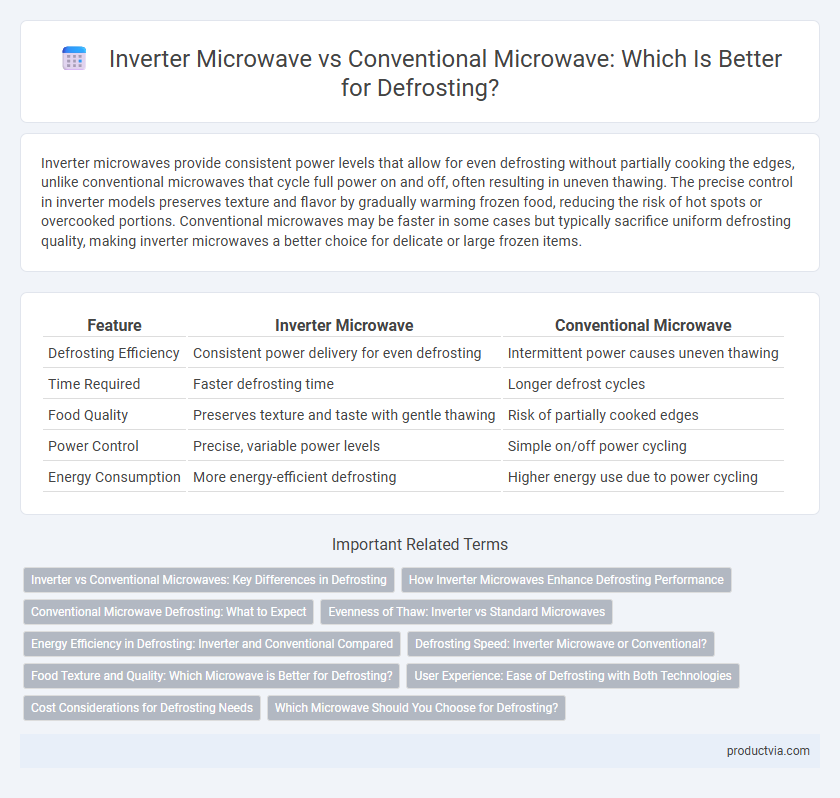Inverter microwaves provide consistent power levels that allow for even defrosting without partially cooking the edges, unlike conventional microwaves that cycle full power on and off, often resulting in uneven thawing. The precise control in inverter models preserves texture and flavor by gradually warming frozen food, reducing the risk of hot spots or overcooked portions. Conventional microwaves may be faster in some cases but typically sacrifice uniform defrosting quality, making inverter microwaves a better choice for delicate or large frozen items.
Table of Comparison
| Feature | Inverter Microwave | Conventional Microwave |
|---|---|---|
| Defrosting Efficiency | Consistent power delivery for even defrosting | Intermittent power causes uneven thawing |
| Time Required | Faster defrosting time | Longer defrost cycles |
| Food Quality | Preserves texture and taste with gentle thawing | Risk of partially cooked edges |
| Power Control | Precise, variable power levels | Simple on/off power cycling |
| Energy Consumption | More energy-efficient defrosting | Higher energy use due to power cycling |
Inverter vs Conventional Microwaves: Key Differences in Defrosting
Inverter microwaves provide a consistent and precise defrosting power by delivering continuous low-level energy, preventing partial cooking and uneven thawing common in conventional microwaves. Conventional microwaves operate with a simple on-off power cycling method, causing temperature fluctuations that often result in cooked edges while the center remains frozen. This key difference in power delivery makes inverter models superior for defrosting delicate foods quickly and evenly.
How Inverter Microwaves Enhance Defrosting Performance
Inverter microwaves enhance defrosting performance by delivering a consistent and precise power level, allowing food to thaw evenly without partially cooking the edges. Unlike conventional microwaves that cycle power on and off, inverter technology maintains a steady energy flow, preserving texture and flavor during defrosting. This precise temperature control reduces thawing times and minimizes nutrient loss, making inverter microwaves superior for delicate defrosting tasks.
Conventional Microwave Defrosting: What to Expect
Conventional microwave defrosting uses intermittent power cycles to thaw frozen food, which can result in uneven heating and partially cooked edges. This method relies on manual time and power adjustments, often requiring users to pause and rotate items to improve thawing consistency. Expect longer defrost times and a higher risk of texture changes or moisture loss compared to inverter microwave technology.
Evenness of Thaw: Inverter vs Standard Microwaves
Inverter microwaves provide consistent power levels that enable even thawing by precisely controlling microwave energy, preventing partially defrosted or overcooked edges. Conventional microwaves operate at full power with on/off cycles, often resulting in uneven thawing and hot spots. This precise energy modulation in inverter technology ensures uniform defrosting, preserving food texture and quality.
Energy Efficiency in Defrosting: Inverter and Conventional Compared
Inverter microwaves provide precise power control, enabling consistent and quicker defrosting while using less energy compared to conventional microwaves that cycle power on and off, leading to uneven heating and longer defrost times. Studies show inverter technology can reduce energy consumption by up to 30% during defrosting tasks due to its continuous power output. Conventional microwaves typically waste energy with fluctuating power levels, resulting in less efficient defrosting and higher electricity costs.
Defrosting Speed: Inverter Microwave or Conventional?
Inverter microwaves offer significantly faster defrosting speeds compared to conventional microwaves due to their precise power control that delivers consistent and even heat. Conventional microwaves often use a simple on/off magnetron cycle, leading to uneven defrosting and longer thawing times. Users benefit from inverter technology with reduced partial cooking during defrosting, preserving food texture and flavor.
Food Texture and Quality: Which Microwave is Better for Defrosting?
Inverter microwaves provide consistent and precise power levels that prevent uneven heating and minimize partial cooking during defrosting, preserving the food's original texture and juiciness. Conventional microwaves operate with full power pulses followed by pauses, often causing some parts of the food to begin cooking while others remain frozen, leading to uneven texture and moisture loss. For superior defrosting quality, inverter technology better maintains the food's integrity by ensuring gentle, even thawing.
User Experience: Ease of Defrosting with Both Technologies
Inverter microwaves provide consistent and even power levels, allowing precise control during defrosting, which reduces uneven thawing and partial cooking. Conventional microwaves cycle on and off at full power, often causing hot spots and longer defrost times, making the process less predictable and requiring more user monitoring. Users report that inverter technology simplifies defrosting by combining faster results with minimal food texture degradation, enhancing overall convenience and efficiency.
Cost Considerations for Defrosting Needs
Inverter microwaves offer precise power control for even defrosting, reducing the risk of partial cooking and food waste, which can save money over time despite their higher initial cost. Conventional microwaves use fixed power levels that may lead to uneven defrosting, potentially causing inconsistent texture and longer defrosting cycles, but they are generally more affordable upfront. For regular defrosting needs, the cost-benefit balance depends on frequency of use and efficiency priorities, with inverter models providing long-term value through energy savings and food preservation.
Which Microwave Should You Choose for Defrosting?
Inverter microwaves provide more precise and consistent power levels for defrosting, resulting in evenly thawed food without partially cooking the edges. Conventional microwaves rely on cycling full power on and off, often causing uneven defrosting and longer wait times. For defrosting, an inverter microwave is the better choice due to its efficient temperature control and reduced risk of overcooked spots.
Inverter Microwave vs Conventional Microwave for defrosting Infographic

 productvia.com
productvia.com